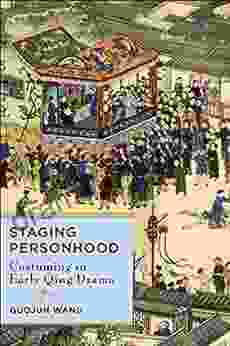Why Some Teams Pull Together And Others Don't: A Comprehensive Examination of Team Dynamics

In today's competitive business landscape, teamwork is more important than ever before. Teams that are able to work together effectively can achieve great things, while teams that are plagued by conflict and dysfunction can quickly derail even the best-laid plans.
5 out of 5
| Language | : | English |
| File size | : | 2096 KB |
| Text-to-Speech | : | Enabled |
| Enhanced typesetting | : | Enabled |
| Word Wise | : | Enabled |
| Print length | : | 21 pages |
| Screen Reader | : | Supported |
So what makes the difference between a successful team and a failing team? There are many factors that contribute to team success, but one of the most important is team dynamics.
Team dynamics refer to the complex interactions that occur between team members. These interactions can be positive or negative, and they can have a significant impact on the team's ability to achieve its goals.
Positive team dynamics are characterized by trust, respect, and open communication. Team members are willing to share their ideas and opinions, and they are able to work together to resolve conflicts. They are also supportive of each other, and they are willing to go the extra mile to help the team succeed.
Negative team dynamics, on the other hand, are characterized by conflict, mistrust, and closed communication. Team members are reluctant to share their ideas and opinions, and they are often unwilling to work together to resolve conflicts. They may also be critical of each other, and they may not be willing to go the extra mile to help the team succeed.
There are a number of factors that can contribute to negative team dynamics, including:
- Lack of clear goals. Teams that do not have clear goals are more likely to experience conflict and dysfunction. This is because team members may have different ideas about what the team is trying to achieve, and this can lead to disagreements and misunderstandings.
- Lack of leadership. Teams that lack strong leadership are more likely to experience conflict and dysfunction. This is because team members may not know who to turn to for guidance and support, and this can lead to a sense of uncertainty and insecurity.
- Lack of trust. Teams that lack trust are more likely to experience conflict and dysfunction. This is because team members may not be willing to share their ideas and opinions, and they may be reluctant to work together to resolve conflicts.
- Lack of communication. Teams that lack open communication are more likely to experience conflict and dysfunction. This is because team members may not be able to communicate their needs and concerns, and this can lead to misunderstandings and disagreements.
Negative team dynamics can have a number of negative consequences, including:
- Reduced productivity. Teams that are plagued by conflict and dysfunction are less likely to be productive. This is because team members may be spending more time arguing and less time working on their tasks.
- Increased turnover. Teams that are plagued by conflict and dysfunction are more likely to experience turnover. This is because team members may be more likely to leave the team in search of a more positive work environment.
- Damaged reputation. Teams that are plagued by conflict and dysfunction can damage their reputation. This is because negative team dynamics can create a negative perception of the team and its members.
Given the importance of team dynamics, it is important for leaders to take steps to create a positive and supportive team environment. Here are a few tips:
- Set clear goals. Teams that have clear goals are more likely to be successful. This is because team members know what they are working towards, and they are more likely to be motivated to achieve their goals.
- Provide strong leadership. Teams that have strong leadership are more likely to be successful. This is because team members know who to turn to for guidance and support, and they are more likely to be confident in the team's ability to achieve its goals.
- Build trust. Teams that have trust are more likely to be successful. This is because team members are more willing to share their ideas and opinions, and they are more likely to work together to resolve conflicts.
- Encourage communication. Teams that have open communication are more likely to be successful. This is because team members are able to communicate their needs and concerns, and this can help to prevent misunderstandings and disagreements.
By following these tips, leaders can help to create a positive and supportive team environment that is more likely to achieve success.
Team dynamics are a complex and important factor in team success. By understanding the different factors that contribute to positive and negative team dynamics, leaders can take steps to create a positive and supportive team environment that is more likely to achieve success.

5 out of 5
| Language | : | English |
| File size | : | 2096 KB |
| Text-to-Speech | : | Enabled |
| Enhanced typesetting | : | Enabled |
| Word Wise | : | Enabled |
| Print length | : | 21 pages |
| Screen Reader | : | Supported |
Do you want to contribute by writing guest posts on this blog?
Please contact us and send us a resume of previous articles that you have written.
 Top Book
Top Book Novel
Novel Fiction
Fiction Nonfiction
Nonfiction Literature
Literature Paperback
Paperback Hardcover
Hardcover E-book
E-book Audiobook
Audiobook Bestseller
Bestseller Classic
Classic Mystery
Mystery Thriller
Thriller Romance
Romance Fantasy
Fantasy Science Fiction
Science Fiction Biography
Biography Memoir
Memoir Autobiography
Autobiography Poetry
Poetry Drama
Drama Historical Fiction
Historical Fiction Self-help
Self-help Young Adult
Young Adult Childrens Books
Childrens Books Graphic Novel
Graphic Novel Anthology
Anthology Series
Series Encyclopedia
Encyclopedia Reference
Reference Guidebook
Guidebook Textbook
Textbook Workbook
Workbook Journal
Journal Diary
Diary Manuscript
Manuscript Folio
Folio Pulp Fiction
Pulp Fiction Short Stories
Short Stories Fairy Tales
Fairy Tales Fables
Fables Mythology
Mythology Philosophy
Philosophy Religion
Religion Spirituality
Spirituality Essays
Essays Critique
Critique Commentary
Commentary Glossary
Glossary Bibliography
Bibliography Index
Index Table of Contents
Table of Contents Preface
Preface Introduction
Introduction Foreword
Foreword Afterword
Afterword Appendices
Appendices Annotations
Annotations Footnotes
Footnotes Epilogue
Epilogue Prologue
Prologue W Winters
W Winters Amy Michelle Mosier
Amy Michelle Mosier John Tulloch
John Tulloch Jana Petken
Jana Petken Blake J Harris
Blake J Harris Matthew Lynn
Matthew Lynn Julia L Mickenberg
Julia L Mickenberg Suzanne Asaff Blankenship
Suzanne Asaff Blankenship Christopher Charlton
Christopher Charlton Sebastian Junger
Sebastian Junger Michelle Terrell
Michelle Terrell Jonily Zupancic
Jonily Zupancic Cory Weagant
Cory Weagant Kristina Mcmorris
Kristina Mcmorris Lena Nemchenko
Lena Nemchenko Elizabeth F Barkley
Elizabeth F Barkley Eric Van Soest
Eric Van Soest Sara Ney
Sara Ney Gerry Conway
Gerry Conway Travis Mays
Travis Mays
Light bulbAdvertise smarter! Our strategic ad space ensures maximum exposure. Reserve your spot today!

 Felix HayesPerilous Lady Crooked Paradise: A Love Story Set in the Glamour and Danger of...
Felix HayesPerilous Lady Crooked Paradise: A Love Story Set in the Glamour and Danger of... Eli BrooksFollow ·11.4k
Eli BrooksFollow ·11.4k Allen GinsbergFollow ·3k
Allen GinsbergFollow ·3k Rod WardFollow ·5.6k
Rod WardFollow ·5.6k Brent FosterFollow ·3.8k
Brent FosterFollow ·3.8k Nathaniel HawthorneFollow ·13.4k
Nathaniel HawthorneFollow ·13.4k Italo CalvinoFollow ·13.9k
Italo CalvinoFollow ·13.9k John SteinbeckFollow ·6.1k
John SteinbeckFollow ·6.1k David MitchellFollow ·7k
David MitchellFollow ·7k

 Jesus Mitchell
Jesus MitchellThe Diabetics Menu: Your Low Carb Options
If you're living with diabetes, you may be...

 Danny Simmons
Danny SimmonsThe Sam Reilly Collection: A Treasure Trove of...
In the realm of...

 Vic Parker
Vic ParkerThe Shepherdess of Siena: The Extraordinary Life of Saint...
Catherine of Siena, known as the...

 Christian Carter
Christian CarterDive into the Mystical World of Meraki Syren: A Literary...
A Literary Odyssey Through the Depths...

 Eric Hayes
Eric HayesSimplest Method on How to Remove Credit Cards from Your...
Do you have multiple credit cards...
5 out of 5
| Language | : | English |
| File size | : | 2096 KB |
| Text-to-Speech | : | Enabled |
| Enhanced typesetting | : | Enabled |
| Word Wise | : | Enabled |
| Print length | : | 21 pages |
| Screen Reader | : | Supported |












